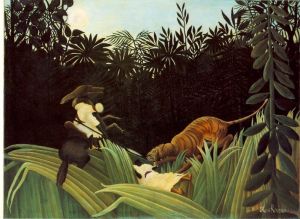Though music and philosophy have been shown to help change perspective as a route to well-being (see Art and the Humanities Shift Our Perspective), the visual arts may be particularly adept at helping viewers modify perspective to improve their well-being. Art plays many roles which potentially contribute to well-being including remembering, providing hope, managing sorrow, rebalancing ourselves by providing clarity of our good qualities, self-understanding, growth and appreciation. Several of these roles may use perspective-shifting: we get to know ourselves, we re-evaluate experiences, we see new reasons to move forward with hope, we learn that we are not alone in our suffering, and we become aware of the beauty in our everyday life. Art is a reflection of ourselves and the human experience, and viewing art through the eyes of the artist provides us a different perspective of ourselves and our world (see de Botton, 2013).
This perspective shifting concept came alive to me at the Barnes Museum as I was forced, no required, to sit in front of one painting that I found compelling. I chose Scout Attacked by a Tiger, by Rousseau. Though I didn’t think I would gain much from investing 20 minutes staring at a painting, I quickly began to associate the painting with various aspects of my life and world. First, I realized the dark theme of the painting paralleled my preferred choice of novels – suspense and mystery novels. I have been told by a professional writer that such books help the reader feel in control of a scary world. The killer is caught. Justice is served.
Next, the composition of the painting also spoke to me during my contemplation. The central focus of Rousseau’s painting is the dead scout, recently mauled by the tiger. However, his companion survives and is poised to kill the tiger: Man triumphs over the cruelty of nature. Surrounded by this macabre scene is the beauty and order of the jungle, lavish and richly colored with a lovely symmetry to the plants that surround and seem to emanate from the death. The jungle itself and light of the sky above also provide a rich contrast to death, and reminds one that life and death are inseparable and are integral to the natural order of the world. I re-evaluated and was reminded of reasons to move forward with hope. In other words, my previous sense of need to control a chaotic and scary world shifted to a more accepting posture after completing the assignment.
The Barnes Museum itself was an exercise in shifting perspective. The museum eschewed the linear, two-dimensional portrayal of art, instead opting for a multidimensional, multimedia approach (see article by Panero, 2013). Barnes’ art arrangement is also an art form and a means of artistic expression; Barnes happened to use masterpieces as his medium. Like my experience with Scout, after an initial “huh?” I was blown away by how this shift exploded my perception of art, and in several ways, my world.
The ability of art to shift the perspective of the artist and the viewer provide interesting possibilities for the study of well-being. Since the humanities is a form of human expression, then humanities and the arts can be studied across time, distance and context. For example, traditional psychology involves use of undergraduate psychology students participating in a contrived experience where they are told they are being tested for X but are really tested for Y. However, psychologists may instead study alternative forms of human expression. For instance, the World Well-Being Project (see references listed on http://wwbp.org/publications.html) studies human expression in the form of social media to unravel the nature, prevalence and frequency of positive emotion across the world. Likewise, one could study the work of an artist such as Renoir over time to understand how life circumstances such as chronic pain and illness influences artistic expression. Thus, one could study art, literature, music, philosophy or other works from the humanities to study well-being.
In this context, the Barnes Museum provides an evocative exploration of human expression. The nonlinear arrangement of art illuminates relationships, ideas, stories, and images that would have been previously unknown. To the degree that the art on a single wall of the Barnes spans the globe, time, theme and media, Barnes is connecting previously unseen but nevertheless important dots for the viewer. Those connections, now evident to the patient observer, provide changes in perspective and renewed understanding of ourselves, either to improve our personal well-being or for new avenues of scientific exploration.
In summary, the humanities are a form of human expression that allows both the creator and observer of the art to improve their well-being. Perspective change can help the artist repair mood, constructively ruminate and build positive emotion. The observer can benefit from the broadened perspective and positive emotion conveyed by the art by simply improving their mood or health, or by shifting their own perspective. That change of perspective may foster hope, help manage sorrow or isolation, inspire, educate or provide new avenues for research.
Resources:
de Botton, A., & Armstrong, J. (2013). Art as Therapy. London: Phaidon Press.
Panero, J. (2011). Outsmarting Albert Barnes. Philanthropy Magazine. Retrieved from http://www.philanthropyroundtable.org/topic/donor_intent/outsmarting_albert_barnes
